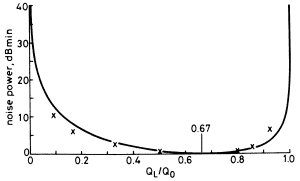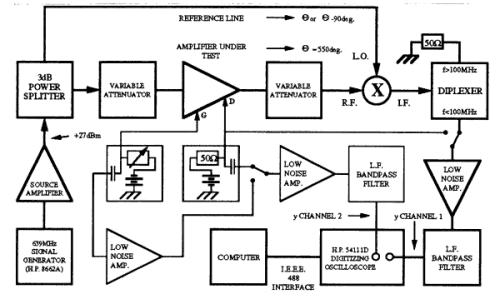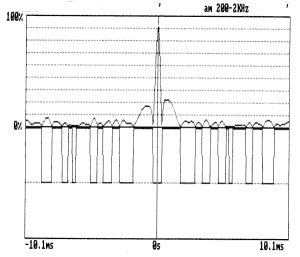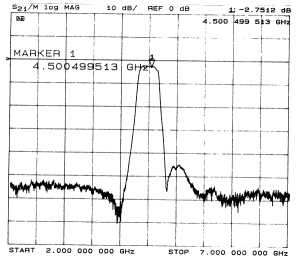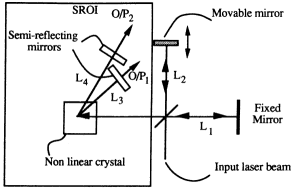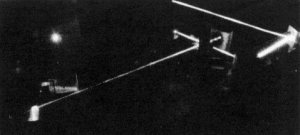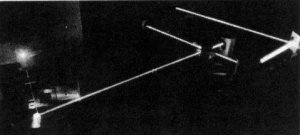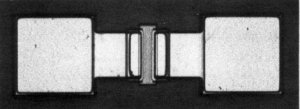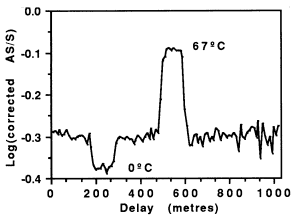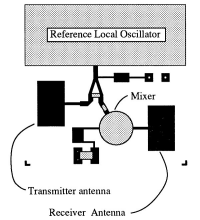RADIO MICROWAVE AND
OPTICAL CIRCUITS
Jeremy
K.A. Everard
BAE Systems/Royal Academy of Engineering Research
Chair in
Low Phase Noise Signal Generation
Department of Electronics
University of York
Heslington, York, YO10-5DD,UK
Tel: 44-(0)1904-322410
email: jkae@ohm.york.ac.uk
Introduction:
Radio, Microwave and Opto-electronic circuits share
similar aims; i.e. the processing of electromagnetic waves. Differences
arise because of the changes in wavelength, 3 metres
to 0.3 microns, and the way that these signals interact with lumped and
distributed components.
This web page describes the
work on Radio, Microwave and Optical Circuits at the Department of Electronics,
University of York. It is shown that new electronic, opto-electronic
and optical developments occur when radio techniques are applied to optics and
vice versa. The following list describes the project areas under investigation.
This web page is all in one
document. It can therefore be seen either by: scrolling down the page or
by highlighting titles in the Index.
LATEST NEWS:- PhD
STUDENTSHIP on Compact Atomic Clocks
A fully
funded PhD studentship (3 years) is potentially available for a highly
qualified candidate. This would start in October
2011.
----------------
The aims of
this project will be to:
Develop
compact Atomic Clocks (Rubidium) with ultra low phase
noise and excellent long term stability.
Introduction:
Atomic
clocks offer very high long term stability and accuracy by using hyperfine
energy level transitions which occur at microwave frequencies. These hyperfine
transitions are very stable and accurate and therefore International time is
defined using atomic clocks which are compared around the world. The definition
for a second is currently based on transitions in Caesium.
Sophisticated
communications and satellite systems (including GPS) often use small atomic
clocks to maintain accuracy. It is this area of high performance compact atomic
clocks that we wish to investigate here.
Background:
Currently
the group at York has done an extensive literature survey and is setting up a
research bench which includes the facilities to produce a variety of Rubidium
clocks based on:
1) Standard excitation using a
Rb gas cell which is optically pumped using a Rb gas lamp. The transmission of the Rubidium optical line
through the cell is monitored on a photodiode array. A microwave signal is then
applied to the gas cell and the frequency adjusted until a dip is observed in
the optical signal. This is due to the optical and microwave interaction
causing a change in the carrier populations in the hyperfine lines. The
microwave signal can then be locked to this dip.
2) CPT
(Coherent population trapping). In this system a single frequency (single
longitudinal mode) laser (VCSEL) is modulated such that the spacing between two
sidebands can be made to occur at the same frequency difference as the
hyperfine spacing. This laser can then be made to populate the hyperfine lines
to cause a change in the optical transmission of the laser light through the
cell. The variation in intensity vs sideband spacing
frequency is then used to frequency lock the oscillator to the hyperfine lines.
Aims:
To develop
a sophisticated work bench as descibed in the
background and use this to develop both standard and CPT (Coherent population
trapping) atomic clocks
To do
theoretical and experimental verification of all the major parameters involved
in these clocks
To develop ultra-Low phase noise oscillators (crystal and dielectric)
and new synthesiser techniques.
To optimise these parameters
To produce
an optimised compact atomic clock with performance
better than the current state of the art both in terms of long term and short
term stability.
Expertise:
To have and
further develop:
Expertise and interest in high frequency and microwave electronics and
optoelectronics offering ultra low noise performance.
An understanding of the Physics of Hyperfine atomic splitting.
We will be
collaborating with the UK National Physical Laboratory (NPL) and some EU
companies.
-----------------
Any
interested candidates should contact Prof Jeremy Everard.
LATEST NEWS 2: OSCILLATORS NOW AVAILABLE FROM YORK
These oscillators offer
very low phase noise (Table 1) up to 40dB better than available elsewhere. They
also offer good temperature stability around 1ppm/K
without temperature stabilisation. The oscillators
typically offer both mechanical tuning (~1%) and electronic tuning to enable phase
locking . Some of the oscillators have been designed for large commercial organisations and can operate over large temperature
ranges.
|
Frequency |
Oscillator Type |
Phase Noise, 10kHz, dBc/Hz |
Noise Floor dBc/Hz |
Electronic Tuning |
Modulation Bandwidth |
|
10MHz |
|
-121@1Hz -149@10Hz |
<-163 |
few Hz |
|
|
1.25GHz |
DRO |
-173 |
<-180 at
50kHz |
Yes |
|
|
1.5GHz |
CRO |
-127 |
<-165 |
3MHz |
>2MHz |
|
4GHz |
DRO |
-152 |
<-170 |
250kHz |
>200kHz |
|
8GHz |
DRO |
-123 |
<-170 |
Yes |
|
|
10GHz |
DRO |
-135 |
<-170 |
300kHz |
>200kHz |
Table 1:
Typical phase noise produced in oscillators availalable
from York. Check back for improved performance.
INDEX:
INTENSIVE ONE WEEK COURSES ON: RF and
MICROWAVE CIRCUIT DESIGN: Design, build and measure your own:
100MHz low noise amplifier - design and
build matching networks for low noise, measure frequency response and noise
figure.
100MHz low phase noise oscillator
- design, build and measure open loop characteristics, close loop, measure
phase noise - agrees with theory
100MHz bandpass
filter.
Book:
Fundamentals
of RF Circuit Design with Low Noise Oscillators, Wiley, December 2000, pp.310,
Hardback, reprint Oct 2002.
- Back
Cover Details
- Table of
Contents
- Preface
- Order
from Wiley
- Corrections and comments from readers for
1st printing (Not for reprint October 2002):
- -page 103, Equation 3.22 is missing
squared (^2) in two places where the reference should be from Hayward [2]
not Gonzalez [1].
- ie add
items in bold: (2g11g22 - Re(y12y21))^2
and !y12y21!^2
- -page 110 Equation 3.50 should have
squared outside bracket
- -page 144 - 154 where it says Z = 1
and Y = 1 circles, it is actually just the real part ie
R = 1 and G = 1.
- -page 151 Figure 3.28. In the LC
diagram at the top right hand corner the inductor should be a capacitor
and the capacitor an inductor.
- -page 152 item 8, add
bold: Z0jX = jwL
- - page 182, Equation 4.3 the denominator
should read 'Rloss+Rin+Rout+j(...'
instead of 'Rloss+Rin+j(...'.
- -page 182 Equation 4.7 the
denominator should read (Rout + Rloss + Rin) instead of (Rout + Rout + Rin).
- - Page 219 Fig 4.31. In the box joining
the upper arm to the lower arm of the feedforward
amplifier the equation should be (1-K1)/GK1 rather than (1-K1)/G.
- - Page 247 where kT
should be -174dBm not -74dBm.
- Comments for Reprint October 2002: None so far.
RF
AND MICROWAVE CIRCUIT DESIGN
RF/Microwave Low Noise Oscillators
Flicker Noise Measurement and Reduction
Tunable Resonators and Low Loss Filters
Broadband Power Efficient RF and Microwave Amplifiers
Microwave Broadband Negative
Group Delay Circuits
Four
papers published IEEE Frequency Control Sympoium May
2003
OPTOELECTRONICS
INCLUDING ALL OPTICAL SWITCHING
AND
OPTICAL FIBRE SENSORS
Dynamic Self Routing All Optical Switches
Picosecond Opto-Electronics
Optical Fibre Spectrum Analysers
Optical Fibre
Sensors
MMIC
Implementations of Opto-Electronic and Microwave
Circuits
Teaching
Fourth Year Projects 2001
Selected
Publications
Selected Patents and Patent Applications
Personal Interests - Ultra Lightweight Miniature
Radio Controlled Aircraft
USEFUL
WEB PAGES:
Jeremy Everard - Department of Electronics web page
Communications Research Group,
Department of Electronics, University of York
Department of Electronics, University of
York web page
University of York web page
RF/Microwave Low Noise Oscillators
Liang
Zhou, Yiming You, Marc Salin,
C. Broomfield, J K A Everard
Theories have been developed which show how minimum sideband noise can be
obtained in oscillators. It is shown that there are a number of optimum
coupling coefficients between the resonator and amplifier as illustrated in the
figure below. Typically the optimum noise performance occurs when QL/Q0 is 1/2
or 2/3 dependent on the definition of power within the oscillator. In
General QL/Q0 = 1/2 is optimum. Low noise oscillators operating
from 1 MHz to 10 GHz have been built which use Inductor Capacitor (LC),
crystal, Surface Acoustic Wave (SAW), Dielectric, Helical and Transmission Line
Resonators. These oscillators demonstrate noise performance usually within 1 dB
of the predicted minimum. MMIC low noise oscillators have been designed and
fabricated. Tunable low noise oscillators (both hybrid and MMIC) have been
built and are under further investigation. Non linear
modelling techniques, using Volterra
Series, have been developed which accurately predict the output power and the
operating frequency. Ultra-low noise reference standards for operation up to 20
GHz are being developed using sapphire dielectric resonators. Present
performance at 7.5 GHz exceeds -143dBc/Hz @ 10 kHz offset. Improvements of
around 35dB are currently under investigation. New techniques have just been
developed (Sept. 2000 see publications, patent applications and book below)
which suppress the flicker noise by 20dB down to the thermal limits for offsets
above 10kHz. The phase noise results are now within 1/2 dB of the
theoretical minimum noise performance set by thermal noise. This is
achieved by using feedforward amplifiers as the oscillator
sustaining stage and incorporating the limiting elsewhere.
Supported by EPSRC
|
Flicker Noise Measurement and Reduction
J K A Everard, P Dallas
Flicker noise causes considerable degradation to the performance of oscillators
and dividers which use GaAs. A system for measuring
the low frequency Flicker noise on the gate and drain of a GaAs
FET and the AM and PM components that these Flicker noises transpose onto a
carrier has been developed as shown below. This system has been used to measure
the cross correlation between the low frequency and the demodulated high
frequency noises by measuring all the components simultaneously on a digitizing
oscilloscope. These measurements can be used to determine the Flicker noise
sources in GaAs FETs and the correlation between
them. Flicker noise reduction techniques in GaAs FET
oscillators are being investigated. Transposed Gain Oscillators offer -143 dBc/Hz @ 10 kHz offset at 7.5 GHz. New techniques have just
been developed (Sept. 2000 see publications, patent applications and book
below) which suppress the flicker noise by 20dB down to the thermal limits for
offsets above 10kHz. The phase noise results are now within 1/2 dB of the
theoretical minimum noise performance set by thermal noise. This is
achieved by using feedforward amplifiers as the
oscillator sustaining stage and incorporating the limiting elsewhere. Low
frequency feedback for flicker noise suppression is now being re-investigated
and optimised.
Supported by EPSRC
|
Tunable Resonators and Low Loss Filters
J K A Everard
New design techniques have been applied to microwave bandpass
filters to demonstrate compact low cost filters using transmission lines,
helical resonators and capacitors. Stripline filter
structures which demonstrate very low radiation loss have been developed as
shown. These filters do not require screening boxes and have the inherent high
Qs of the materials used. Unloaded Qs of 520 have been obtained at 5 GHz in
unscreened filters and unloaded Qs of 80 have been achieved at 21GHz on
microwave resonators. New resonators (both hybrid and MMIC) which can tune over
a near octave frequency range have been developed for use in tunable microwave
oscillators and filters. New high Q (235 at 2GHz) very compact resonators and
filters base on printed helical resonators have been developed. These
have been designed to ensure that the standing wave current is near zero through
the via hole. Resistive loading has been used to suppress even order responses.
Ultra high Q resonators operating at room
temperature are currently under investigation. Room temperature Qs of 24,000
and 60,000 are readily achieved with simple structures using BaTiO3 and
Sapphire respectively. New structures with a 10 fold improvement in Q (at
room temperature) are currently being modelled and
investigated.
Supported by EPSRC
|
Broadband Power Efficient RF and Microwave Amplifiers
J K A Everard
Broadband power efficient Class E amplifiers have been developed for use from
120 to 180 MHz. New CAD techniques were developed to
implement the rapid design and evaluation of such circuits. New circuits which
present the optimum complex impedance to the active device over a broad
frequency range have been developed. These design techniques are now being
extended to produce hybrid, microstrip and MMIC
versions operating above 900 MHz for use in mobile telephones and
communications systems. Distributed load networks have been developed which
produce efficiencies greater than 75% with 500 mW
output power at 1 GHz. A 'real time' load network simulator has been written
which allows full tuning of the component values and frequency while observing
the waveforms at all the nodes in 'real time' on an oscilloscope like display.
Microwave
Broadband Negative Group Delay Circuits
C
Broomfield, J K A Everard
Microwave negative group delay circuits offering octave bandwidths have
recently been produced - see Electronics letters November 2000, Vol. 36, No33.
Dynamic Self Routing All Optical Switches
J K A Everard, M Page-Jones
All optical Switches have been developed which automatically route optical data
signals where the data, destination address and optical power are all contained
within the single optical laser beam. This is the optical equivalent of the old
Strowger Exchange. A new all optical system with one
input and three outputs has recently been demonstrated at the Royal Society
using an input optical power of 300 micro-watts. This is believed to be the first
all optical switch which contains the data, destination address and power
all within the same 300 microwatt I/P laser beam. The switch operates by
automatically producing a diffraction grating within an non
linear crystal which rotates according to the destination address.
The coding is carried within the autocorrelation of the input signal which in
this case is the distance between adjacent pulses.
|
Picosecond Opto-Electronics
J K A Everard, N Ghogomu
Ultra-fast opto-electronic detectors and mixers have
been developed with bandwidths extending from DC to 50 GHz (5 ps rise time). Most recently a 3-wave opto-electronic
mixer has been demonstrated which detects two optical signals spaced 33 GHz
apart. These signals are detected and downconverted
to 500 MHz all within the same device. MMIC versions, as illustrated below,
have been fabricated and shown to work. Analysis predicts performance often
better than ideal photodiodes. These devices are being used for coherent
detection and downconversion and as phase detectors
for phase locking semiconductor lasers. Current devices demonstrate a sensistivity of -60dBm @ 33GHz in a 1MHz bandwidth with a
S/N=1. Shot Noise limited subpicosecond devices are
currently being investigated.
|
Optical Fibre Spectrum Analysers
J K A. Everard, M Page-Jones
An optical fibre spectrum analyser
has been built which uses a Michelson fibre
interferometer to measure the autocorrelation function and hence the spectrum
of optical signals. The autocorrelation function is obtained by using the
stretching of polarisation maintaining fibre in a balanced configuration. Differential delays of 3
cms in a scan time of 50 ms
have been achieved. Techniques for joining Andrews single mode elliptically
cored fibre to D fibre with
transmission greater than 80% have been developed. This allowed all fibre systems to be built. These systems can also be used
for fibre sensors and for programming the all optical
self-routing switches
Supported by EPSRC
Optical Fibre
Sensors
J K A Everard, N Ghogomi, R Thomas, M
Page-Jones
Microwave radar techniques (Spread Spectrum Raman OTDR) have been used to
develop a distributed optical fibre temperature
sensor capable of measuring the temperature distribution over a Kilometre of fibre with degree
sensitivity and metre spatial resolution as shown
below. Coherent Brillouin temperature sensors have
been demonstrated and are under further investigation. New sensors with sub
meter resolution are being developed.
Supported by EPSRC and
University of York
|
MMIC Implementations of Opto-Electronic
and Microwave Circuits
J K A Everard
Oscillators, tunable resonators, filters, high efficiency amplifiers and
photoconductive three wave optical mixers and detectors have been built on
hybrid and monolithic microwave integrated circuits (MMIC's). Currently
complete radio transmitters (including the power efficient RF amplifier) and
receivers are being designed on monolithic microwave integrated circuits and
have already been built in hybrid form. A microwave Doppler Radar is shown
below. Coherent optical receivers and downconverters
incorporating the microwave oscillators are being designed.
Supported by EPSRC
|
Future Projects
RF and Microwaves:
Ultra
Low Noise Tunable Reference Oscillators with Phase Noise ~ -180dBc at 10kHz
offset at X band
Broad
Tuning Low Noise VCOs
Highly
Power Efficient Low Noise Oscillators
Linear
Broadband Highly Efficient Power Amplifiers
High Q
Printed Filters and Resonators
Optoelectronics:
High
Resolution Distributed Temperature Sensing using Brillouin
Backscatter From Optical Fibres
Sub-picosecond
Optoelectronic Detectors operating above 1 Tera-Hertz
Waveguide
All Optical Self-routing Switches
Teaching
RF and
Microwave Circuit Design: 4th year MEng course, Part of Masters MSc in
Communications and 1week courses for industry as part of the Integrated
Graduate Development Scheme (IGDS). These courses can also be taken
individually or within a part time MSc. <>
The course reviews the fundamentals of RF circuit theory, and then describes
the detailed design principles used in RF receiver and transmitter design.
These include:
Component models including: bipolar transistors, FETs, diode detectors, printed
and wirewound inductors, surface mount resistors and
capacitors
S,Y,Z parameter definition, conversion manipulation and calculation. - Equiivalent circuit model extraction using parameter
manipulation.
Low noise small signal amplifiers including: matching, (matching network Q),
noise matching and noise measurement techniques and biasing.
Broadband small signal amplifiers, feedback for optimum input and output
impedance
Low Phase Noise Oscillators
Frequency Synthesizers
Power amplifiers - Real time time Large signal modelling
Mixers
Filters
To support the design
process active/passive device models and construction techniques are described.
Practical design and
measurement techniques are included in the extensive laboratory classes.
Highlights include the design, construction and measurement of a low noise
amplifier, a filter and a low phase noise oscillator. Frequency response
measurements are performed on the amplifier and filter. Noise
measurements are performed on the amplifier. Open loop characterization and
closed loop phase noise measurements are performed on the oscillators. The
results are compared with theory. Modern CAD techniques (using HP/EESOF Series
IV software) will be introduced.
Analogue Circuit Design - e.g. design of silicon based opamp integrated circuits
9 lecture course on the internal design of operational amplifiers (1
lecture/week)
3 Tutorials/workshops in weeks 3, 6, 9
Year 2/3, Term two
Syllabus: The monolithic operational amplifier
- internal construction and circuit topologies. T and pi transistor models -
gain and impedance variation with current at LF, frequency response, hybrid
parameters, fT, Miller Effect, common base and cascode. Difference amplifier - differential and common
mode gain. Current sources/mirrors (Wildar/Wilson) –
Early voltage, active loads, O/P impedance, calculation of Voltage Offsets.
Output stages: Class A - Emitter follower + current source; I/P and O/P
impedance, transfer characteristics and distortion. (Complementary output
stages, Class B, Class A/B). Some Op-Amp
circuits - effect of feedback on I/P and O/P impedance and stability.
Recommended Text
Book: Analysis and Design of Analogue Integrated
Circuits, Paul R. Gray and Robert G. Meyer - Wiley
Additional
Reading:
Fundamentals of RF circuit design with low noise oscillators, Jeremy Everard - Wiley
Provisional Timetable:
Lecture 1 + 2
Aims of course
Introduction to operational amplifiers
Ideal op amp; high I/P, Low O/P impedance, effect of feedback on input and
output resistance for inverting/non inverting opamps.
Gain Bandwidth product - compensation.
Application circuits: Adder
and D to A, Integrator, Schmitt Trigger, Logarithmic Amplifier – Triangular
Waveform generator with SPICE simulation.
Lecture 3 + 4
Circuit Topologies
T and pi transistor models: gain and impedance variation with current at LF
Frequency response - Hybrid parameters and fT -
Miller Effect/capacitance - component value multipliers/dividers
Common Base
Cascode
Lecture 5 + 6
O/P impedance of common emitter amplifier with external emitter resistor
O/P impedance of Cascode
Difference amplifier:
Large Signal Performance
Emitter degeneration for linearisation
Differential and Common Mode Gain
Lecture 7 + 8
Current sources/mirrors (Wildar/Wilson)– Early
Voltage
Active Loads – Small Signal Gain
Gain and O/P impedance of emitter coupled difference
amplifier with active loads
Calculation of Voltage Offsets
Lecture 9
Output stages: Class A, Emitter follower + current source; I/P and O/P
impedance,
transfer characteristics and distortion.
(Complementary output stages, Class B, Class A/B)
Additional notes
available on request – not in exam
Modern IC Processes
Analogue Filter Design (3rd year)
9 lecture course, 3 workshops and two labs (Sallen
and Key)
Approximation: Butterworth and Chebyshev functions
and Pole positions
Synthesis: RC Sallen and Key: LC ladder networks,
calculation of normalised values using Darlington
insertion loss technique and Cauer expansion
Frequency and impedance denormalisation. Low pass to
high pass and bandpass conversion.
Former Teaching:
Electromagnetism and Engineering Physics
Opto-electronics
Typical Final year
(third and fourth year) projects:
Low noise oscillators
High Q printed resonators and filters
High Efficiency amplifiers
Radio Receivers - FM tuners, amateur radio
Transceivers - Amateur radio
TV Satellite Receivers (10 GHz)
Printed Doppler Radar modules using patch Antennas and dielectric
resonators (10.67GHz).
Miniature radio controlled aircraft
Steam powered radio controlled aircraft
Optical fibre
lasers
Fourier Transform optical spectrum analyser
Optical fibre LIDAR for distributed temperature
sensing using Raman Backscatter
Holographic movie projector
Optical fibre intercom
INTENSIVE 1 WEEK COURSE FOR INDUSTRY ON RF CIRCUIT DESIGN
The course reviews the fundamentals of RF circuit theory, and then describes
the detailed design principles used in RF receiver and transmitter design.
These include:
Component models including: bipolar transistors, FETs, diode detectors, printed
and wirewound inductors, surface mount resistors and
capacitors
S,Y,Z parameter definition, conversion manipulation and calculation
Low noise small signal amplifiers including noise measurement techniques
Broadband small signal amplifiers, feedback for optimum input and output impedance
Low Phase Noise Oscillators
Frequency Synthesizers
Power amplifiers
Mixers
Filters
To support the design
process active/passive device models and construction techniques are described.
Practical design and
measurement techniques are included in the extensive laboratory classes.
Highlights include the design, construction and measurement of a low noise
amplifier, a filter and a low phase noise oscillator. Frequency response
measurements are performed on the amplifier and filter. Noise measurements
are performed on the amplifier. Open loop characterization and closed loop
phase noise measurements are performed on the oscillators. The results are
compared with theory. Modern CAD techniques (using HP/EESOF Series IV software)
will be introduced.
Contact: email: jkae@ohm.york.ac.uk
-44-1904-432410
-44-1904-433024
44-1904-432319 - Course information from the continuing education office.
Course Information
from CPD Office
1. Ultra-stable Low
Noise Oscillators
The aim of this project is to develop low noise tuneable
oscillators operating at the theoretical minimum phase noise level or
ultra-stable dielectric resonators oscillators using Bragg type structures with
Qs around ½ million at 10GHz. These oscillators will incorporate:
1. Printed high Q
resonators
2. Ultra-high Q dielectric resonators
3. Microwave amplifiers optimised for minimum
flicker noise
4. Optimum varactor coupled resonators
The work will involve both
analytical, experimental and CAD optimisation of
circuits using HP EESOF software capable of both circuit and field-based
analysis. Circuits will be based on microstrip and
coplanar circuit design. This work is well supported with a new EPSRC grant and
microwave test equipment operating up to 40GHz.
There is a good chance of
publication in an academic journal. Previous years
work has been published.
2. Printed Doppler
Radar
The aim of the project is to develop a doppler radar
module (10.675GHz) using patch antennas and Silicon Germanium based oscillators
using printed or dielectric resonator oscillators.
This will require:
1. Design of Patch antennas at 10GHz
2. Design of low noise oscillators using printed or dielectric resonators
3. Design of microwave mixers
4. Design of low noise amplifiers and filters.
5. Use of advanced CAD tools.
3. RF/Microwave
Spectrum Analyser
The aim of this work will be to develop a high performance spectrum analyser operating up to 3GHz using high technology low
cost printed microwave boards.
This will involve the
design of:
1. Low Noise Oscillators
2. low phase noise rapid tuning frequency Synthesisers
3. Low pass and band pass filters
4. amplifiers and mixers.
The designs will involve
the use of analytical, experimental and CAD techniques using the latest
software and microwave test equipment. There is a good chance of
publication, of new oscillator circuits, in an academic journal .
4. Miniature
Surveillance Aircraft
The aim of this work will be to develop very small radio controlled aircraft
incorporating a camera. The project will involve the development of:
1 Very lightweight
radio control
2. miniature aircraft design
3. Development of optimum thrust and flight duration.
4. Development of miniature camera and transmitter electronics.
The project will involve
the use of modern RF/microwave circuit design techniques applied to miniature
electronic circuits and the development of miniature avionics systems.
Highly Efficient
Multi-band Power Amplifiers for Mobile Telephones
The aim of this project is to develop highly efficient power amplifiers
operating between 900MHz and 1.8GHz. These amplifiers will incorporate:
1. Review of best designs
currently on the market.
2. High Q resonators using printed transmission lines, coils and capacitors.
3. Non linear device modelling.
4. Optimisation of the amplifier for high efficiency.
5. Optimisation of the amplifier for linear and low
spurious response during switch on and off.
The work will involve both
analytical, experimental and CAD optimisation of
circuits using HP EESOF software which is capable of both circuit and
field-based analysis. Circuits will be based on microstrip
and coplanar circuit design. This work is well supported with a new EPSRC grant
and microwave test equipment operating up to 50GHz. There is a good chance of
publication in an academic journal. Previous year’s work has been published.
Sponsorship from companies is also possible.
Other projects in the RF
and Microwave area and optoelectronics are also available.
Consultancies
RF and
Microwave Circuit and System Design:
Low Phase Noise Oscillators; High Efficiency and Conventional Amplifiers;
Printed Filters, Mixers and Antennas
Spectrum Analyser Design
Compact Microwave Dopplar Radars
Copyright Infringement of Electronic Circuits
Optoelectronic Design
Selected Publications
Editors D. Haigh and J.K.A. Everard.
"Gallium Arsenide Technology and its Impact on Circuits and Systems".
Published by Peter Peregrinus Ltd., August 31st
1989. Chapter 8 (J.K.A. Everard) on Low noise
oscillators, pp. 237-280.
Selected Academic
Journal Papers (Most Recent First)
J.K.A. Everard
and C. Broomfield, "High Q printed Helical Resonators for Low Noise
Oscillators and Filters”, IEEE Transactions on Ultrasonics
Ferroelectrics and Frequency Control, Vol. 54, No. 9, September 2007, pp 1741-1750. (PDF available from author or
IEEE).
J.K.A. Everard and C. Broomfield, “Reduced Transposed Flicker
Noise in Microwave Oscillators using GaAs based Feedforward Amplifiers”, IEEE Transactions on Ultrasonics Ferroelectrics and Frequency Control. Vol. 54,
No. 6, June 2007, pp.1108 – 1117. (PDF available from author or IEEE).
J.K.A. Everard and L. Zhou. “Non Linear Effects in varactor tuned resonators” IEEE Transactions on Ultrasonics Ferroelectrics and Frequency Control, Vol. 53,
No. 5, May 2006, pp.853 – 861. (PDF available from author or IEEE).
A.J. Wilkinson and J.K.A. Everard. "Transmission
Line Load-Network Topology for Class E Power Amplifiers". IEEE
Transactions on Microwave Theory and Techniques, Vol. 49, No. 6, June 2001,
pp.1202-1210. (PDF available from author or IEEE).
Jeremy Everard "Fundamentals of RF Circuit Design with
Low Noise Oscillators" ISBN 0 47149793 2, Wiley - December 2000
CD Broomfield and J.K.A. Everard “Broadband negative
group delay networks for compensation of oscillators, filters and communication
systems". Electronics Letters, Vol.23, November 2000, pp1931 -
1933. (PDF Available from Author)
J.K.A. Everard and C.D. Broomfield “Transposed
flicker noise suppression in microwave oscillators using feedforward
amplifiers. Electronics Letters, Vol.20, September 28th 2000, pp.
1710-1711. (PDF available from Author)
J.K.A. Everard "A Tutorial on: "The
Fundamental Theory of Low Noise Oscillators with Specific Reference to some
Detailed Designs" IEEE Frequency Control Symposium, 130 slides, June
2000 Kansas City - Available at the UFFC website -.
P.A. Dallas and J.K.A. Everard,
"Characterization of flicker noise in GaAs
MESFETs for oscillator applications" IEEE Transactions on Microwave
Theory and Techniques, Vol. 48, No. 2, February 2000, pp. 245-257. (PDF
available from author or IEEE)
N.N. Ghogomu and J.K.A. Everard.
“Coherent Photoconductive Detection of Brillouin
Scattering for Temperature Sensing”. Electronics Letters, August 1995, Vol. 31,
No. 18pp.1606-1607.
J.K.A. Everard and M.A. Page-Jones. “All
Optical Remote Switching for Multiplexed Optical Fibre
Sensors and Communications Systems” IEEE Journal of Lightwave
Technology, July 1995, Vol. 13,No.7, pp. 1277-1281. (PDF available from
author)
K.K.M. Cheng and J.K.A. Everard. “A New Technique for
the Quasi-TEM Analysis of Conductor backed Coplanar Waveguide Structures”. IEEE
Transactions on Microwave Theory and Techniques. September 1993,
Vol. 41, Number 9, pp.1589-1592. (PDF available from author)
J.K.A. Everard and K.K.M. Cheng. “High performance
Direct Coupled Bandpass filters on Coplanar Waveguide”.IEEE Transactions on Microwave Theory and
Techniques. September 1993, Vol. 41, Number 9, pp.1568-1573. (PDF
available from author)
J.K.A. Everard, A.K. Powell, M. Page-Jones and T.
Hall. “Self Routing Optical
Interconnects” Electronics Letters 12th March 1992, Vol. 28 No. 6,
pp. 556-558. K.K.M. Cheng and J.K.A. Everard.
“Accurate Formulae for Efficient Calculation of the Characteristic Impedance of
Microstrip Line. IEEE Transactions on Microwave
Theory and Techniques. September 1991, Vol. 39, Number 9,
pp.1658-1661.
K.K.M. Cheng and J.K.A. Everard."Noise
Performance Degradation in Feedback oscillators with non
zero phase error", Microwave and Optical Technology Letters. Vol.4,
No.2, 20 Jan 1991, pp.64-66.
K.K.M. Cheng and J.K.A Everard "Semi-lumped
Element Microwave Bandpass Filter". Microwave
and Optical Technology Letters, June 1990, Vol.3, No.6, pp.212-214.
M. Page-Jones and J.K.A. Everard. "Optical Fibre Spectrum Analyser"
Electronics Letters 18th January 1990.Vol.26, No.2. pp. 117-118.
J.K.A. Everard, K.K.M. Cheng and P.A. Dallas. "A
High Q Helical Resonator for Oscillators and Filters in Mobile Communications
Systems" Electronics Letters, 23rd November 1989, Vol. 25, No.24, pp.
1648-1650.
K.K.M. Cheng and J.K.A. Everard "X band
Monolithic Tunable Resonator/Filter". Electronics Letters, 9th November
1989, Vol.25, No.23, pp.1587-1589.
E.J. Austin, A. Bar-lev, J.K.A. Everard.
"Theoretical study of a Double Quantum Well Photoconductive Device"
Journal of the Institute of Physics, Semiconductor Science and Technology,
November 1st 1989, Vol.4, Issue 11, pp.931-937.
J.K.A. Everard and R. Thomas. "Coherent
Detection of Stimulated Brillouin Backscatter on a
Photo-conductive Three Wave Mixer for Sensing Applications".
Electronics Letters 31st August 1989, Vol. 25, No.18 pp.1236-1237.
K.K.M. Cheng and J.K.A. Everard. "Novel varactor tuned transmission line resonator".
Electronics Letters, 17th August 1989, Issue 17, Vol. 25, pp.1164-1165.
J.K.A. Everard and K.K.M. Cheng. "Novel Low
noise 'Fabry Perot' transmission line
oscillator". Electronics Letters, 17th August 1989, Issue 17, Vol. 25,
pp.1106-1108.
J.K.A. Everard and R. Thomas "Distributed
optical fibre temperature sensor using spread
spectrum techniques" Elec. Letters, 19th January 1989 Vol.25, No. 2,
pp.140-142.
J.K.A. Everard and A.J. King "Broadband Power
Efficient Class E Amplifiers with a non Linear CAD Model of the Active
Device". Journal of the IERE, March/April 1987, Vol. 57, No. 2, pp. 52-58.
J.K.A. Everard "Low Noise Power Efficient
Oscillators: Theory and Design" IEE Proceedings Part G, Vol. 133, No.4,
August 1986, pp. 172-180.
J.K.A. Everard
and J.E.Carroll. "Practical Comparisons of Opto-electronic sampling systems and devices". IEE
Proc. Vol.130, Part I,Feb. 1983. pp. 5-16.
Selected Conference Publications (Most Recent First)
Jeremy Everard and Keng Ng, ‘Ultra-Low Phase Noise Crystal Oscillators’, 2007
Joint European Frequency and Time Forum and the IEEE Frequency Control
Symposium, Geneva, Switzerland, 29th May to 1st June 2007.
Jeremy K.A. Everard ‘Low Phase Noise Oscillators
Including Some Detailed Designs’, 2007 Joint European Frequency and Time Forum
and the IEEE Frequency Control Symposium, Geneva, Switzerland, 29th May to 1st
June 2007. INVITED
Jeremy K.A. Everard and Konstantinos
Theodoropoulos ‘Ultra-Low Phase Noise Ceramic based
Dielectric Resonator Oscillators’, IEEE Frequency Control Symposium, Miami USA,
June 2006.
Liang Zhou and Jeremy Everard , ‘Non-Linear Effects
In Varactor Tuned Resonators’, Proceedings of the
2003 IEEE International Frequency Control Symposium held jointly with the
European Frequency and Time Forum, Tampa USA, May 2003, pp. 853 – 860.
Carl Broomfield and Jeremy Everard, ‘High Q Printed
Helical Resonators And Filters’, Proceedings of the 2003 IEEE International
Frequency Control Symposium held jointly with the European Frequency and Time
Forum, Tampa USA, May 2003, pp. 819 - 822.
Carl Broomfield, Yiming You, Richard Parsons
and Jeremy Everard, ‘Broad Tuning Microwave
Oscillators Utilising Multilayer Technology And Sige Devices’, Proceedings of the 2003 IEEE International
Frequency Control Symposium held jointly with the European Frequency and Time
Forum, Tampa USA, May 2003, pp. 417 - 422.
Marc Sallin (Visiting from ETH), Liang Zhou, Carl
Broomfield and Jeremy Everard, ‘Broad Tuning Ultra
Low Noise Dielectric Resonator Oscillators operating At 10GHz Utilising Ceramic Based Resonators’, Proceedings of the
2003 IEEE International Frequency Control Symposium held jointly with the
European Frequency and Time Forum, Tampa USA, May 2003, pp. 411 - 416.
J. Everard and C. Broomfield, “Flicker Noise Removal
in Microwave Oscillators using GaAs based Feedforward Amplifiers”. Proceedings of the IEEE
International Frequency Control Symposium, June 4th - 8th, 2001, Seattle
Washington, USA, pp.156-161.
J. Everard and C. Broomfield, “Reduced Flicker
Noise in Microwave Oscillators using Feedforward
Amplifiers”. Proceedings of the IEEE Microwave Theory and Techniques Symposium,
May 20th - 25th, 2001, Phoenix, Arizona, USA, pp.1431-1434.
C.D.Broomfield and J,.K.A. Everard.
“Flicker noise reduction using GaAs microwave feedforward amplifiers” Proceedings of the 2000 IEEE
International Frequency Control Symposium 7th –9th June 2000, Kansas
City, pp525-530.
C. Broomfield, M.A. Page-Jones and J.K.A. Everard
“Low Noise X-band Dielectric Resonator Oscillators using BaTiO3 and Sapphire
Dielectric Resonators. IEE Colloquium on Microwave and mm-wave Oscillators and
Mixers. 1st December 1998 pp. 6.1 - 6.6.
J.K.A. Everard “Low Noise Oscillators - A review” IEE
Colloquium on Microwave and mm-wave Oscillators and Mixers. 1st December
1998 pp1.1 - 1.10.
J.K.A. Everard and J. Bitterling “Low Phase Noise
Highly Power Efficient Oscillators” 1997 IEEE International Frequency Control
Symposium, May 27th-30th, Orlando, USA, pp919-924 (PDF available from the
Author).
J.K.A. Everard “A Review of Low Noise Oscillator,
Theory and Design” 1997 IEEE International Frequency Control Symposium, May
27th-30th 1997, Orlando, USA, pp.909-918. (PDF available from
author)
M.A. Page-Jones and J.K.A. Everard. “Enhanced
Transposed Gain Microwave Oscillators”. European Frequency and Time Forum, 5th
to 7th March, Brighton 1996, pp.275-278.
J.K.A. Everard. “Low Noise Oscillators, Theory and
Design” Invited paper at the European Frequency and Time Forum, 5th to 7th
March, Brighton 1996, pp.436-441.
J.K.A. Everard and M.A. Page-Jones, “Ultra Low Noise
Microwave Oscillators with Low Residual Flicker Noise”, IEEE International
Microwave Symposium, Orlando May 16th -20th 1995, pp. 693-696.
J.K.A. Everard and M.A. Page-Jones. “All
Optical Remote Switching for Multiplexed Optical Fibre
Sensors”. Post deadline paper, 10th International Optical Fibre Sensors Conference, OFS(10), Glasgow, October 11th to
13th, 1994.
N.N. Ghogomu and J.K.A. Everard.
“Brillouin Temperature Sensing with a Photoconductive
Mixer” Post deadline paper, 10th International Optical Fibre
Sensors Conference, OFS(10), Glasgow, October 11th to 13th, 1994.
J.K.A. Everard, A.K. Powell, M. Page-Jones.
“All Optical Self Routing Interconnects” Post deadline paper at CLEO
10th-15th May 1992.
J.K.A. Everard. “Low Noise Oscillators” IEEE
Microwave Theory and Techniques Conference, Albuquerque New Mexico, 1-5th June
1992, pp.1077-1080.
P.A. Dallas and J.K.A. Everard. "Measurement of
the Cross Correlation between Baseband and Transposed Flicker Noises in a GaAs MESFET". IEEE Microwave Theory and Techniques
Conference, Dallas USA, May 1990, pp. 1261-1264.
J.K.A. Everard and R. Thomas "Microwave and mm
Wave Photo-conductive Three Wave Mixers for Coherent Detection and Downconversion of Optical Signals". IEEE Microwave
Theory and Techniques Conference, USA,1990,pp. 237-240.
Selected Patents and Patent Applications Self Routing Optical
Interconnects" UK Patent GB2263371
Greatly Enhanced spatial detection of Optical Backscatter for Sensor
Applications. UK Patent GB 2190186A
Laser Plasma and Optical Resonator Structures,GB8619017
Opto-electronic correlators
and mixers, GB8816250,
Low noise transmission line oscillators, GB8816489
Optical Spectrum Analyser, GB8906702.9,
Helical Resonator" GB8919628.1
Optical Fibre Sensor" GB8919551
Microwave Alarm Sensor" GB 9002106.4
Low Noise Oscillator 0022308.1
Brief
CV
Jeremy Everard obtained his degrees from the
University of London (King's College) and the University of Cambridge in 1976
and 1983 respectively.
He worked in industry for
six years at the GEC Marconi Research Laboratories, M/A-Com and Philips
Research Laboratories on Radio and Microwave circuit design. At Philips he ran
the Radio Transmitter Project Group.
He then taught RF and
Microwave Circuit design, Opto-electronics and
Electromagnetism at King's College London for nine years while leading the
Physical Electronics Research Group. He became University of London
Reader in Electronics at King’s College London in 1990 and Professor of
Electronics at the University of York in September 1993.
In the RF/Microwave area
his research interests include: The theory and design of low noise oscillators
using inductor capacitor (LC), Surface Acoustic Wave (SAW), crystal,
dielectric, transmission line, helical and superconducting resonators; flicker
noise measurement and reduction in amplifiers and oscillators; high efficiency
broadband amplifiers; high Q printed filters with low radiation loss, broadband
negative group delay circuits and MMIC implementations.
His current research
interests in Opto-electronics include:
All optical self-routing switches which route data-modulated laser beams
according to the destination address encoded within the data signal, ultra-fast
3-wave opto-electronic detectors, mixers and phase
locked loops and distributed fibre optic sensors.
He has published papers on:
oscillators, amplifiers, resonators and filters; all optical switching, optical
components, optical fibre sensors and mm-wave
optoelectronic devices and most recently a new book on 'Fundamentals of RF
Circuit Design with Low Noise Oscillators (Wiley). He has co-edited and
co-authored a book on Gallium Arsenide Technology and its impact on Circuits
and Systems and contributed to a book on Optical fibre
sensors. He has filed Patent applications in many of these areas.
He is a member of the Institution of Electrical Engineers, London and the
Institution of Electronic and Electrical Engineers (USA).
Personal Interests
Miniature Radio Controlled Aircraft
Very lightweight electrically powered model
aircraft have been built (34 - 80gms). This work has been the subject of
many final year projects at York. These typically incorporate a 35MHz four
channel FM receiver (2-3gms), speed controller (0.8gms), servos/actuators
(1-3gms). The lightest aircraft is currently a 12 inch Biplane weighing
34gms with throttle and rudder control. The heavier aircraft have flight
duration times of 1/2 hour. Recently Paul Gregory (who graduated from
York in 2002) produced a full avionics package and surveyance
aircraft which use a camera with a 2.45GHz downlink with the frequency
controlled from the ground where servo and frequency control is achieved using
a microprocessor.
RADIO, MICROWAVE AND OPTOELECTRONIC CIRCUITS
Is
variety still the spice of life?
Jeremy K.A. Everard
Department
of Electronics
University
of York
Thursday 30th October 2003 at 7.30pm,
Room P/X001
Physics/Electronics
Building, University of York
Radio,
Microwave and Opto-electronic circuits share similar
aims; i.e. the processing of electromagnetic waves to enhance communications
and control systems which we now regard as essential for everyday life. These
systems vary from mobile phones, radar, cars, air and spacecraft.
Differences
between radio and optics arise because of the changes in wavelength of the
wave, 3 metres to 0.3 microns, and the way that these
signals interact with the lumped and distributed components within the
circuit. The fundamental mathematics and physics however are the same; it
is just the approximations that are different.
This talk
will describe the work on Radio, Microwave and Optoelectronic Circuits at the
Department of Electronics, University of York. It will be shown that new
electronic, opto-electronic and optical developments
occur when radio techniques are applied to optics and vice versa
Topics to
illustrate these principles will include:
RF and
Microwaves
1.
Low noise (low jitter) oscillators. Oscillators are the reference sine wave
generator in most systems from human beings (the heart) to computers to radio
and radar.
2. High Q printed filters - There are always unwanted
signals with the wanted signal so how do we remove them using printed copper
shapes.
3. Highly efficient broadband amplifiers - conversion
of your battery into a signal that leaves the antenna without wasting power.
4. Broadband negative group delay circuits - Circuits
that appear to have an output before the input arrives.
Optoelectronics
1.
All optical self-routing switches and sensors - Use only light and fibres to pass information around in a controlled way.
2. Distributed optical fibre
temperature sensors - Measure the temperature along the whole channel tunnel
using only a single optical fibre
3. Optical radio
4. Optical fibre spectrum analysers - Measure the characteristics of light using
optical fibres
jkae Sept 2007
